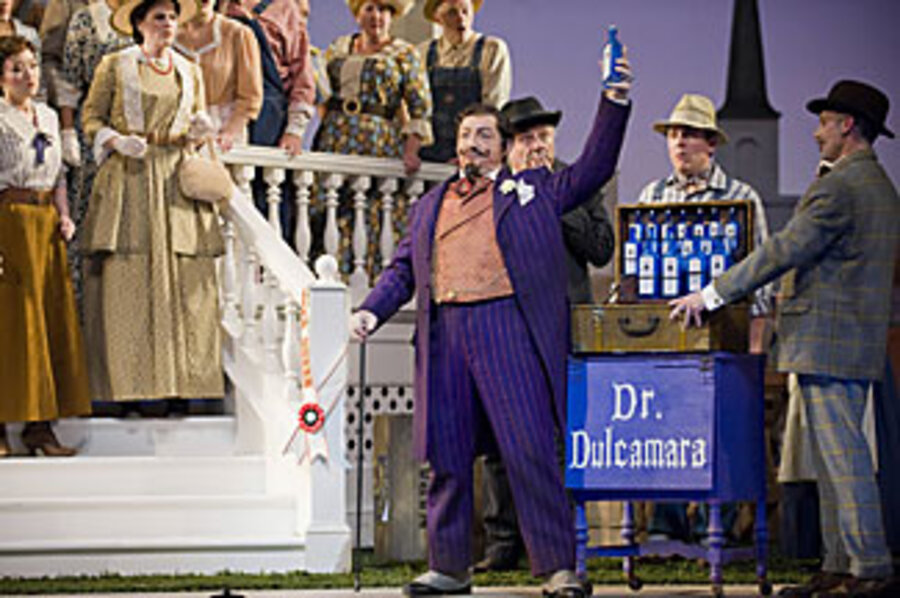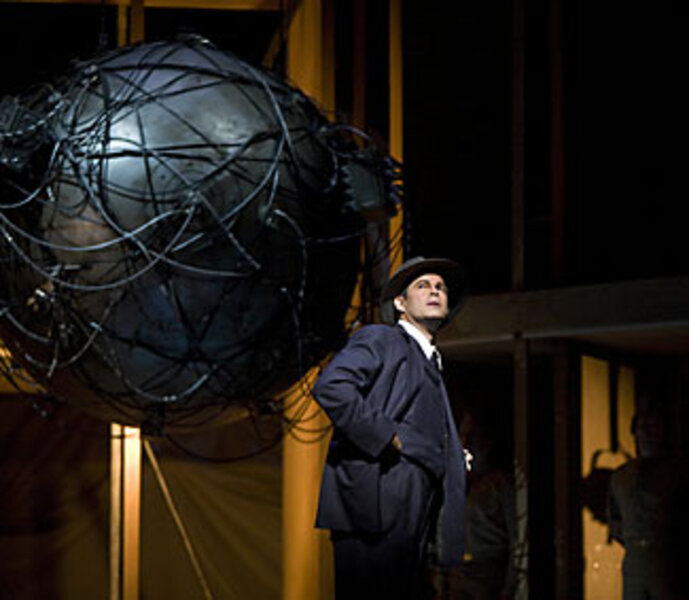Opera reaches for new scale
Loading...
| San Francisco
Teenagers in motley dress ranging from elegant party frocks to droopy jeans mill around the front entrance to the opera house in downtown San Francisco, awaiting the final dress rehearsal of the company's "Elixir of Love."
It's High School Night at the opera, a charmingly civil effort to bring the city's youth to its deepest cultural fountain, in the hope they will drink and enjoy. In fitting, grand opera tradition, this tableau plays out against a larger scrim of bad news in the opera world: Opera Pacific just ceased operation, Michigan Opera Theatre canceled the final show of its season, and New York City Opera just lost its cutting-edge new Belgian artistic director for lack of funds. Companies from New York to San Francisco are embracing everything from cheaper costume fabrics to fewer lights to cut costs.
But, say most opera watchers, there has rarely been a time when this most famously expensive art form didn't dance with financial disaster. The current woes mask a much larger and more meaningful story about the changing place of this 409-year-old European art form in American life, says Dana Gioia, departing chairman of the National Endowment for the Arts (NEA). "Opera has come of age in the United States," says Mr. Gioia.
In recognition, the NEA two weeks ago awarded the first new federal arts medals in 26 years, the NEA Opera Honors. This past week, the Los Angeles Opera announced Ring Festival L.A., its first-ever 10-week arts festival anchored by a six-day production of Richard Wagner's four-opera "Ring" cycle slated for 2010. This citywide cultural collaboration showcases the world-class work of the L.A. Opera under superstar tenor, Placido Domingo, says expert Leslie Dunton-Downer, author of the reference book, "Opera."
By a wide array of measures, this "most civic of art forms," as Gioia calls it – for centuries an opera house has been the measure of a city's aspirations – is in full domestic flower. Since 1965, the number of opera companies has nearly tripled from 46 to 129 full-time groups and that many again in part-time and festival-based companies.
Beyond that – and perhaps more important – since 1990, American opera companies have premiered more than 200 new works by modern composers. Nearly every opera company in the country has a new work somewhere in its schedule, says Anthony Freud, general director of Houston Grand Opera and chairman of Opera America, the New York-based trade association. A generation ago, this was not true, but companies realize they must find ways to keep the art form alive "or risk becoming completely irrelevant," says Mr. Freud.
American composers such as Pulitzer-prize winner John Adams ("Nixon in China," "Death of Klinghoffer") have led the search for a more meaningful art form. "The stories are from our own time and they involve what I call mythic themes of American life," says Mr. Adams, who just released his memoir "Hallelujah Junction."
From Boston to Boise, companies of all sizes have embraced new works. According to Opera America, in 2006-07 alone North American companies opened 10 new world premieres. This drive for a fresh idiom combined with the introduction of supertitles, enabling opera patrons to follow the onstage action in English, has helped swell audiences nearly 45 percent over the past 20 years. In 2006-07, opera drew roughly 20 million viewers.
But new works can also challenge the established patron base for many opera companies, including the venerable New York Metropolitan Opera, says General Manager Peter Gelb, who says when he arrived at the Met two years ago "the company was fusty and in danger of becoming remote from modern audiences."
Among the array of strategies to combat this, Mr. Gelb pioneered high-definition live simulcasts, beamed via satellite directly into the movie theaters of major cities in 32 countries. This past Saturday's transmission here in Burbank at the AMC 16 Theater drew a respectful crowd for the latest John Adams work, "Dr. Atomic," about the first atomic bomb.
Lifelong Angeleno Vicky Waldman says the event, which aired at 10 a.m., allows ordinary folks with modest means to share in one of the most expensive art forms. "This way we can indulge ourselves for every performance," she says, referring to the $22 ticket price in contrast to $100 and up opera houses charge.
The urgency of remaining relevant to the next generation of potential patrons has led to many community-based initiatives around the country.
Some responses suggest opera can be a tough sell. "My mother made me come," says 14-year-old Nick O'Shea standing on the San Francisco Opera steps and whose rumpled clothing hints that he would prefer to be elsewhere on a Saturday night.
Others in line say they're willing to give the opera a chance. As director of the newly created education division within the San Francisco Opera, Ruth Nott says finding ways to engage this generation is a challenge. "They have so many options for their time," she says, adding that the company will expand its website with such features as audio and video downloads. "These are the ways this generation shares and interacts with entertainment."
As evidenced by the subscribers who turn in their tickets rather than attend an unfamiliar work, outreach efforts do not speak to everyone.
Some critics argue that certain strategies undermine the essence of opera. Too much electronic enhancement takes away from the human voice which is the soul of opera, says Thor Eckert, the professional development coach at the Academy of Vocal Arts in Philadelphia, and former opera critic for this newspaper.
More critical though, he says, is the dumbing down of repertoire and declining vocal standards. Popular opera singers such as Andrea Bocelli do not help the public understanding of the qualities of a well-trained opera singer, he says. "It may sell CDs, but [it] is not a real opera voice."
As history has shown, fertile periods have their own value, says Ms. Dunton-Downer. "It takes many operas to create a few great ones."
Opera has its own power to persuade, as the teens streaming from the performance of "Elixir of Love" make clear.
"I love that it's all sung," says 16-year-old Clare DeZutti, for whom this is her second opera. "There's really nothing else to compare," she says. "I like it because it's so well, primal."






